Cinisello Balsamo
| Cinisello Balsamo | ||
|---|---|---|
| Comune | ||
| Comune di Cinisello Balsamo | ||

Piazza Gramsci.
| ||
| ||
| Location of Cinisello Balsamo in Italy | ||
| Coordinates: 45°33′N 9°13′E | ||
| Country | Italy | |
| Region | Lombardy | |
| Metropolitan city | Milan (MI) | |
| Frazioni | Bellaria, Bettola, Borgo Misto, Campo dei Fiori, Casignolo, Cornaggia, Crocetta, Nigozza, Robecco, Sant'Eusebio, Villa Rachele | |
| Government | ||
| • Mayor | Siria Trezzi | |
| Area | ||
| • Total | 12.7 km2 (4.9 sq mi) | |
| Elevation | 154 m (505 ft) | |
| Population (30 June 2017)[1] | ||
| • Total | 75,611 | |
| • Density | 6,000/km2 (15,000/sq mi) | |
| Demonym(s) | Cinisellesi and Balsamesi | |
| Time zone | CET (UTC+1) | |
| • Summer (DST) | CEST (UTC+2) | |
| Postal code | 20092 | |
| Dialing code | 02 | |
| Patron saint | St. Ambrose | |
| Saint day | December 7 | |
| Website | Official website | |
Cinisello Balsamo [tʃiniˈzɛllo ˈbalsamo] (Lombard: Cinisell Balsom) is a comune (municipality) of about 75,200 inhabitants in the Metropolitan City of Milan in the Italian region of Lombardy, about 10 kilometres (6 mi) northeast of Milan city center.
Cinisello Balsamo borders the following municipalities: Monza, Muggiò, Nova Milanese, Paderno Dugnano, Cusano Milanino, Sesto San Giovanni, Bresso.
The current comune was formed in 1928 by the union of Cinisello and Balsamo, and received the honorary title of city through a presidential decree on 17 October 1972.
Contents
[hide]History[edit]
Until the late 1920s, Cinisello and Balsamo were two separate municipalities. By royal decree, on 13 September 1928 a merger was arranged to form the current common.
As a symbol, the emblem of the city now encompasses those of the two municipalities merged: the emblem of the pastoral and the sword on a red field in fact belongs to Balsamo, the rampant crowned lion on a blue field belongs to Cinisello.
Name[edit]
Cinisello (from the Latin cinis, "Ashes", through cinixellum, indicating the fertility of the land from the ashen color, but traditional, though not exactly confirmed - even if you have found Roman remains in the area - is the theory that "Cinisello" comes from "Cinis Aelii", "Ash of Aelius", a Roman gens had here, probably, a branch of the Imperial Age) is the western part of the city.
In another theory (also not exactly confirmed) resulting from studies done in the Historical Archive of Arms would be that both Cini, both Sello, were ancient and noble Houses from Trentino who settled in the area, providing their names to the same, which were decorated with the title of nobility with special merit achieved for works done in favor of the Fatherland. Balsamo (perhaps "the balsam tree", but it might just be the surname of a noble family and elders of the town in the Middle Ages) is the eastern half.
Main sights[edit]
- Church of Sant'Ambrogio (17th century) in Cinisello
- Small church of Sant'Eusebio, dating from Lombard times
- Shrine of St. Martin Bishop (16th century)
- Church of San Martino (16th century) in Balsamo
- Villa Ghirlanda Silva Cipelletti (16th century) with one of the first Landscape garden in Italy, designed by count Ercole Silva in the early of 19th century
- Gramsci Square is the main square in Cinisello, which is overlooked by the Church of St. Ambrogio and Villa Arconati.
- Church of Saint Pio X (1958)
- Church of Saint Joseph worker (1957)
- Church of Saint Peter (1968)
- Church of Sacred Family (1965)
- Church of Santa Margherita (1961)
- Church of San Bernardino
People[edit]
- Carino of Balsamo, Christian martyr
- Carlo Oriani, (1888) cyclist
- Ernesto Castano, (1939) footballer
- Pierino Prati, (1946) footballer and coach
- Gaetano Scirea, (1953) footballer and coach
- Marco Veronese, (1976) footballer and coach
- Roberto Cammarelle, (1980) boxer
- Sfera Ebbasta, (1992) rapper
Twin towns – sister cities[edit]
See also[edit]
References[edit]
External links[edit]
| Wikimedia Commons has media related to Cinisello Balsamo. |









